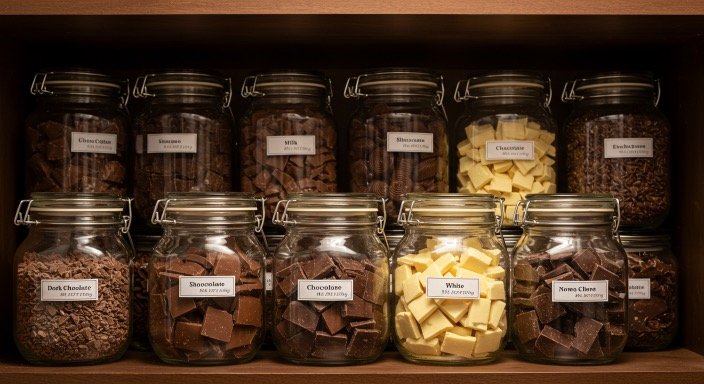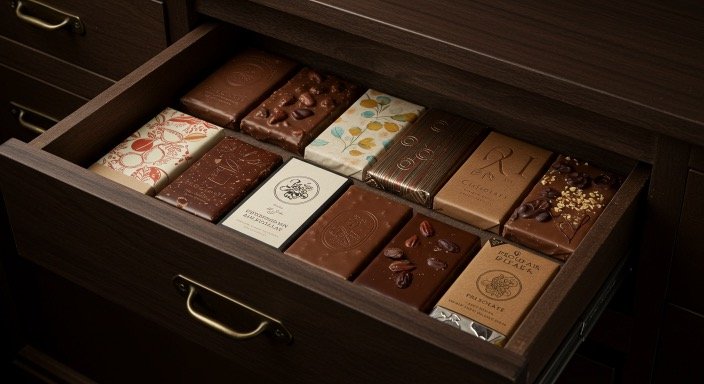How to store chocolate to keep it fresh?
If you’ve ever opened a chocolate bar and found it pale, dull, or dusty instead of glossy and smooth, you’ve seen what poor storage can do. Chocolate may seem durable, but it’s actually quite delicate — sensitive to temperature, light, moisture, and even nearby odors. Whether it’s artisan truffles, baking chips, or your favorite Chocolate Chip Banana Bread, knowing how to store chocolate correctly is key to keeping it fresh and flavorful.
Let’s uncover why chocolate storage matters, what mistakes to avoid, and how you can preserve that perfect texture and taste for months.
Why Chocolate Needs Proper Storage
Chocolate is a fine balance of cocoa butter, sugar, and cocoa solids. When this balance is disturbed by heat, humidity, or light, fat and sugar particles can migrate, causing discoloration or texture changes known as “bloom.”
A study in the Rudvik Engineers found that even small fluctuations in temperature and humidity can trigger bloom by destabilizing fat crystals.
Proper storage is not just about keeping chocolate from melting — it preserves its aroma, snap, and melt-in-the-mouth smoothness.
For more on chocolate’s physical structure, see Dark vs. Milk Chocolate: The Surprising Health Differences You Need to Know.
What Happens When Chocolate Is Stored Incorrectly
Chocolate rarely “spoils” — it doesn’t harbor bacteria easily because of its low water content. But improper storage can ruin its appearance and texture.
There are two common types of bloom:
- Fat bloom: A whitish-gray film that forms when cocoa butter separates and rises to the surface.
- Sugar bloom: A gritty texture that happens when moisture dissolves sugar crystals, which recrystallize as the chocolate dries.
A Michigan State University Study revealed that temperature cycling — moving chocolate repeatedly between warm and cool areas — is one of the main causes of fat bloom.
If you’re fascinated by chocolate science, check out 10 Surprising Chocolate Facts You Didn’t Know.
The Ideal Temperature for Storing Chocolate

How to Store Chocolate to Keep It Fresh
Chocolate prefers a cool, consistent environment — ideally between 60°F and 70°F (15°C–21°C) — and relative humidity below 50%.
The Hawaiian Host Group recommends storing chocolate in a dark, dry area away from heat and strong smells. Cocoa butter readily absorbs nearby aromas, so avoid storing chocolate next to coffee, onions, or spices.
If your home is warm or humid, store chocolate in an airtight container with silica packets to absorb moisture.
You can apply similar storage care when preserving baked goods like Chocolate Graham Crackers.
Should You Store Chocolate in the Fridge?
Most chocolatiers say no — only refrigerate chocolate when absolutely necessary. Fridges are cold but humid, and condensation can create sugar bloom.
If your kitchen often exceeds 75°F (24°C), refrigeration may be your best option. Wrap chocolate tightly in foil, then seal it inside an airtight container to prevent moisture or odor absorption.
For more on how chocolate health benefits change with storage, see Is Dark Chocolate Really Healthy?.
Freezing Chocolate: Is It Safe?

How to Store Chocolate to Keep It Fresh
Freezing chocolate isn’t ideal but works for long-term storage if done properly. Rapid temperature shifts can cause fat bloom, but gradual cooling minimizes that risk.
Here’s how to freeze chocolate safely:
- Wrap tightly in foil or plastic wrap.
- Place in a freezer-safe airtight bag.
- Move it to the fridge for 24 hours before freezing.
- To thaw, reverse the process — fridge first, then room temperature before unwrapping.
This same care applies when baking with frozen chocolate — for example, in your Chocolate Chip Banana Bread.
Humidity: The Silent Enemy
Humidity above 50% can wreak havoc on chocolate. It dissolves surface sugars and triggers bloom, making chocolate appear blotchy and taste gritty.
A Dry Air study confirmed that even moderate moisture exposure affects gloss and mouthfeel.
For humid environments, store chocolate in sealed containers with desiccant packets or dry rice, and avoid refrigerating unless absolutely necessary.
If you love warm drinks, check out Bone Broth Hot Chocolate: The Surprising Superfood Drink You’ll Actually Love — proper storage helps maintain cocoa’s deep flavor in recipes like this.
Shelf Life: How Long Does Chocolate Last?

How to Store Chocolate to Keep It Fresh
Chocolate’s longevity depends on its cocoa and dairy content. Here’s a quick guide:
| Type | Shelf Life | Notes |
| Dark Chocolate | 1–2 years | Longest-lasting, minimal dairy |
| Milk Chocolate | 8–12 months | More sensitive to heat |
| White Chocolate | 6–10 months | Prone to oxidation |
| Truffles / Filled Chocolates | 1–3 months | Consume quickly; fillings perish fast |
For ready-to-drink options, see Choco Milk Review: All What You Need to Know.
Common Chocolate Storage Mistakes
Here are some easy-to-make mistakes that lead to loss of flavor or appearance:
- Using thin plastic wrap instead of airtight containers.
- Storing chocolate near the oven or stove.
- Exposing it to sunlight or strong kitchen lights.
- Mixing milk and dark chocolates in the same container.
A National Library of Medicine study confirmed that light exposure speeds up oxidation, affecting both antioxidants and flavor stability.
How Chocolatiers Do It
Professional chocolatiers store finished bars and bonbons at 60–65°F (16–18°C) and 45–55% humidity, according to the Valrhona Collection
You can replicate those conditions by storing your bars in a dark cabinet away from appliances. Consume truffles within two weeks for the best experience.
For more fascinating facts about chocolate craftsmanship, see 10 Surprising Chocolate Facts You Didn’t Know.
Eco-Friendly Chocolate Storage
Want to protect your chocolate and the planet? Skip disposable wraps and try beeswax wraps or reusable glass jars. These reduce odor absorption and waste.
The Sustainable Packaging Coalition emphasizes reusable packaging as key to reducing food waste — including sweets.
Final Thoughts
Learning how to store chocolate properly is an act of respect for both flavor and craftsmanship. Chocolate is chemistry, art, and pleasure all in one — and when you store it right, it rewards you with the texture and aroma that make it irresistible.
Keep it cool, dark, and dry. Protect it from moisture and temperature swings. And when you finally unwrap it, enjoy every smooth, rich bite knowing you’ve kept it as its maker intended.
For more mindful indulgence, explore Sweet Freedom: The Ultimate Guide to Becoming a Sugar Defender — because great chocolate is best enjoyed with balance and care.
🍫🍫🍫🍫🍫

